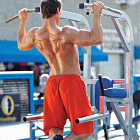 Q: What’s the best type of chinup to perform? I see many variations used and was wondering if I should vary my chinups every few weeks?
Q: What’s the best type of chinup to perform? I see many variations used and was wondering if I should vary my chinups every few weeks?
A: Start with the basics. The three basic grips are supinated (palms facing your body), semisupinated (palms facing each other) and pronated (palms facing away from your body). When you use a pronated grip, it’s called a pullup. The pronated grip puts the least amount of stress on your wrists, elbows and shoulders. If you alternate these three chinup variations and progressively add resistance using a chin/dip belt as you get stronger, you will experience great results.
The grip that will let you handle the most weight is a semisupinated, medium grip—with your hands about 22 to 24 inches apart. That places your elbow flexors in their most effective line of pull, making it the chinup variety on which you will most likely be able to use additional resistance.
When you’re ready to take your training to the next level, the exercise I consider the king of upper-back exercises is the sternum chinup. It was popularized by bodybuilding pioneer Vince Gironda, who earned the nickname “Trainer to the Stars” by training many Hollywood celebrities, such as Clint Eastwood and Denzel Washington. Gironda also trained many elite bodybuilders, such as Larry Scott, who won the first Mr. Olympia in 1965 and repeated as champion the following year before retiring.
The sternum chinup is unique in that it combines many different movements. The start of the exercise resembles a classical chinup, the midrange a pullover, and the end a row. This chinup requires you to hold your torso in a layback posture throughout the entire exercise. As you pull yourself to the bar, lean your head back as far from the bar as possible, and arch your spine. Toward the end point of the movement your hips and legs should be at a 45 degree angle to the floor. Keep pulling until your collarbones pass the bar, your lower sternum makes contact with the bar, and your head is parallel to the floor. Use either a supinated grip or a pronated grip, and vary it from narrow to shoulder width—the latter requires more strength.
Editor’s note: Charles Poliquin is recognized as one of the world’s most suc-cessful strength coaches, having coached Olympic med-alists in 12 different sports, including the U.S. women’s track-and-field team for the 2000 Olympics. He’s spent years researching European journals (he’s fluent in English, French and German) and speaking with other coaches and scientists in his quest to optimize training methods. For more on his books, seminars and methods, visit www.CharlesPoliquin.com. Also, see his ad on page TK. IM




















You must be logged in to post a comment Login